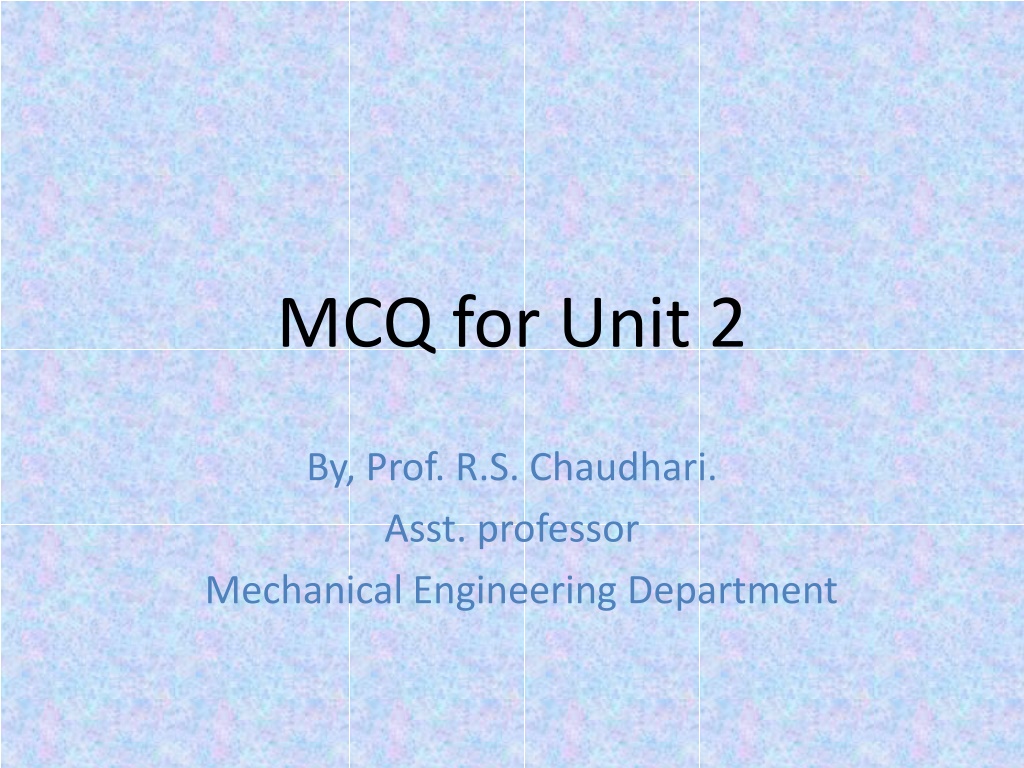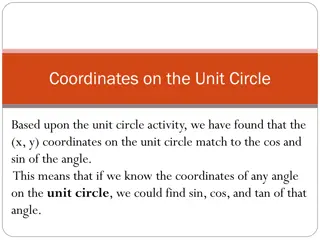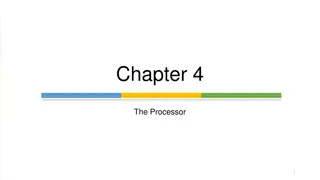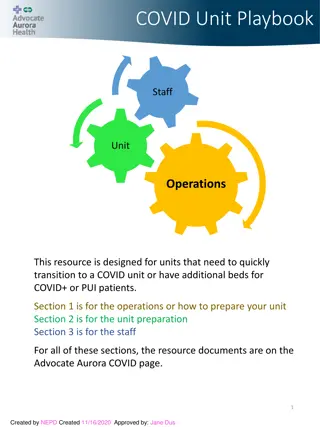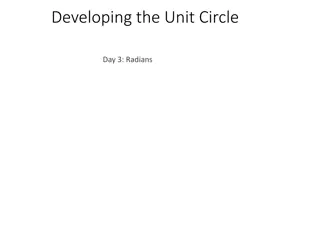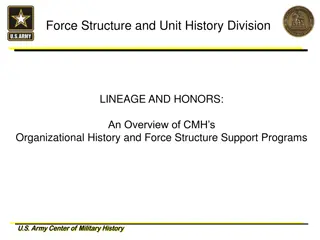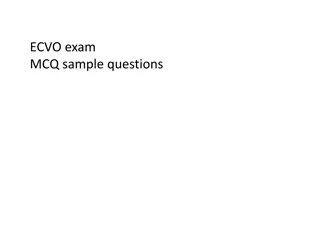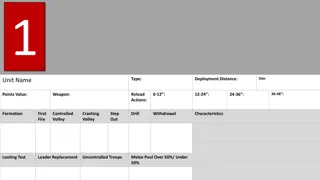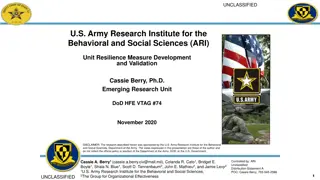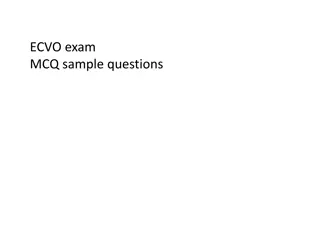MCQ for Unit 2
In this MCQ set for Unit 2, explore questions on inertia force, equilibrium of rigid bodies, simple harmonic motion, pendulum oscillation, and more. Test your knowledge in mechanical engineering with these multiple-choice questions.
Uploaded on Feb 20, 2025 | 0 Views
Download Presentation

Please find below an Image/Link to download the presentation.
The content on the website is provided AS IS for your information and personal use only. It may not be sold, licensed, or shared on other websites without obtaining consent from the author. Download presentation by click this link. If you encounter any issues during the download, it is possible that the publisher has removed the file from their server.
E N D
Presentation Transcript
MCQ for Unit 2 By, Prof. R.S. Chaudhari. Asst. professor Mechanical Engineering Department
Q.1 Inertia force acts _____. (a) perpendicular to the accelerate force. (b) along the direction of acceleforce. (c) opposite to the direction of accelerate force. (d) in any direction w.r.t. accelerate force depending on the magnet two.
Q.2 A rigid body is Said to be in equilibrium if ________. (a) ??=0. (b) ??=0 (c) ??=0 (d) all of the above
Q.3 In simple harmonic motion _________. (a) the acceleration is inversely proportional to displacement. (b) the acceleration is always equal to zero. (c) the acceleration is directly proportional to displacement. (d) none of the above
Q.4 In a simple pendulum the time of oscillation depeds upon ________. (a) mass of the pendulum and the length of the pendulum (b) mass of the pendulum and the local acceleration due to gravity (c) total acceleration due to gravity and length of pendulum (d) mass of the pendulum, the length of pendulum ad the blocal acceleration due to gravity.
Q.5 In simple Harmonic Motion the acceleration is---- ----- a) directly proportional to displacement b) inversely proportional to displacement c) directly proportional to velocity d) inversely proportional to velocity
6 If the radius of gyration of a compound pendulum about an axis through C.G. is more, then its frequency of oscillation will be .. a) less b) more c) same d) data are insufficient to determine same
Q.7 The Bifilar suspention method is used to determine a) natural frequency of vibration b) position of balancing weights c) moment of inertia d)centripetal acceleration
Q.8 The simple method to find mass moment of inertia of connecting is a) compound pendulam b) Bifilar suspention c)Trifilar suspention d) All of above
Q.9 The mass moment of inertia of flywheel can be determine by ________. a) Compound pendulum b) Bifilar suspention c) Trifilar suspention d) All of above
Q.10 The period of oscillation of bifilar suspention system is given by .. a) tp=2?? ? ? ?? b) tp=??? ? ??? c ) tp=2?? ?? ? ? d) tp=2?? ? ? ??
Q.11 In bifilar suspention system if two wires are attached are equal distance from C.G. of rigid body then period of osciiilation is given by .. a) tp=2?? ? ? b) tp=2? ?? ? c) tp=2? ? ?? d) tp=2?? ? ?
Q.12 The period of oscillation of trifilar suspension system is given by . a) tp=2?? ? ?? b) tp=2?? ? ? ? c) tp=??? ? ? ? d) tp=2?? ? ? ?
Q. 13 If k = radius of gyration of compound pendulum about axis through C.G., l = distance of C.G. from axis of suspension, then the period of oscillation of the compound pendulum will be________. (a) 2? ? ? ?(b) 2? ?2+?2 ?2+?2(d) 2? ??+?? ? (c) 2? ??
Q. 14 Acompound pendulum can be treated for analysis as simple pendulum if _________. (a) length of compound pendulum is same as that of simple pendulum (b) mass of compound pendulum is same as that of simple pendulum (c) time period of oscillation of compound pendulum is same as that of simple pendulum (d) compound pendulum and simple pendulum give time period of oscillation of only 1 sec
Q. 15 When l=k, the time period of oscillation of compound pendulum is _________ (a) maximum (b) minimum (c) zero (d) 1 sec
Q. 16 The minimum time period of oscillation of compound pendulum is ________ (a) 2? ?? ? (b) 2? ? ? (c) 2? ? ? (d) 2? ? 2?
Q. 17 A connecting rod of mass 5kg is placed on a platform whose mass is 3kg, it suspended by 3 equal wires each 1.5m long from a rigid support. The wires are equally spaced along the circumference of a circle 150mm radius. When the C.G. of connecting rod coincides with axis of circle and platform makes 15 oscillations in 40 sec, find the M.I. of the system. (a) 0.3162 b) 0.2107 (c) 0.4108 (d) 0.1078
Q. 18 A connecting rod of mass 3kg oscillates 50 times in one minute when suspended at a small end. Find its mass moment of inertia about the axis passing through its centre of gravity which is located at 300mm from small end. (a) 0.012 (b) 0.023 (c) 0.042 (d) 0.052
Q.19 A connecting rod of mass 3.5kg is suspended by two wires each of 2m length. The wires are attached to the rod at points 150mm on either side of the centre of gravity. If the connecting rod makes 35 oscillations in 60 seconds. Find the radius of gyration and the mass moment of inertia of the connecting rod about its centre of gravity. (a) 0.0287 (b) 0.0187 (c) 0.0365 (d) 0.0485
Q. 20 A rigid body can be replaced by two masses, connected rigidly together. The system of two masses will be dynamically equivalent to the rigid body if (a) the mass of the two system are the same (b) the centre of gravity of the two mass system coincides with the centre of gravity of the rigid body (c) the total mass moment of inertia of the two mass system about an axis through the centre of gravity is equal to that of rigid body about the same axis (d) all of the above
Q.21 A rigid body , under the action of external forces, can be replaced by two masses placed at a fixed distance apart. The two masses form an equivalent dynamical system, if (a) the sum of two masses is equal to the total mass of the body (b) the centre of gravity of the two masses coincide with that of the body (c) the sum of mass moment of inertia of the masses about their centre of gravity is equal to the mass moment of inertia of the body (d) all of the above
Q.22 Any distributed mass can be replaced by two point masses to have the same dynamical properties if (a) the sum of the two masses is equal to the total mass (b) the combined centre of mass coincides with that of the mass (c) the moment of inertia of two masses about perpendicular axis through their combined centre of mass is equal to that of the rod. (d) all of the above.
Q.23 The rigid body is replaced by two concentrated masses rigidly connected together. The system will be kinematically equivalent of the body if (a) the mass of two masses is equal to the mass of rigid body (b) the centre of gravity of two mass system coincides with the centre of gravity of rigid body (c) the mass moment of inertia of the two mass system and the rigid body about centre of gravity are equal (d ) all of the above.
Q.24 Which one of the following conditions is satisfied for a system to be dynamically equivalent? (a) l1.l2=k2 (b)l1+l2=k2 (c) l1-l2=k2 (d) l1.l2=k2 Where l and l =distance of two masses from C.G of the body, and k= radius of gyration of the body.
Q. 25 Fig. 1 shows a rigid body of a mass m having radius of gyration K about its centre of gravity. It is to be replaced by in equivalent dynamical system of two masses placed at A and B. The mass at A should be (a) ? ? ? (?+?) (b) ? ? ? (?+?) (c) ? 2 (d) ? 3
Q. 26 Figure shows a rigid body of mass m having a radius of gyration K about its centre of gravity. It is to be replaced by in equivalent dynamical system of two masses placed at A and B. The mass at B should be (a) a*m/(a+b) (b) b*m/(a+b) (c) m/2 (d) m/3
Q. 27 Refer figure the mass of rigid body is m and radius of gyration is K. The kinetically equivalent system shows masses m1 and m2. The mass m1 should be _________. (a)m1= ml2/(l1+l2) (b)m1= ml1/(l1+l2) (c)m1= m(l1l2)/ l1+l2 (d) m1= (l2/l1+l2)m2
Q. 28 Refer figure the mass of rigid body is m and radius of gyration is K. The kinetically equivalent system shows masses m1 and m2. The mass m2 should be (a) m2= ml2/(l1+l2) (b) m2= ml1/(l1+l2) (c) m2= m(l1l2)/ l1+l2 (d) m1= (l2/l1+l2)m2
Q. 29 Two systems shall be dynamically equivalent when (a) the mass of two are same (b) example of two coincides (c) M.I. of two about an axis through example is equal (d) All of the above
Q. 30 The essential condition of placing the two masses, so that the system becomes dynamically equivalent is (a) L1.l2 = kG2 (b) L1.l2=kG (c) L1=kG (d) L2=kG Where l1andl2= distance of two masses from the centre of gravity of the body, kG= radius of gyration of the body
Q. 31 For a link to be dynamically equivalent which condition needs to be satisfied? (a)K2=l1/l2 (b)K2=l2/l1 (c)K2=l1/l2 (d)K2=l1+l2
Q. 32 In a dynamically equivalent system, a uniformly distributed mass is divided into _________ point masses. (a) Two (b) Three (c) Four (d) Five
Q. 33 If m is the mass of connecting rod , k is the radius of gyration of connecting rod, k1 is the new radius of gyration of connecting rod, and is the angular acceleration of connecting rod than correction couple is given by __________. (a) TC=m[k2-k12] (b) TC=m[k12-k2] (c) TC=m[k12k2] (d) TC=m/ [k12-k2]
Q.34 Crank effort is the net force applied at the crankpin ___________ to the crank which gives the required turning moment on the crankshaft. Parallel Perpendicular At 450 1350
Q.35 In a reciprocating horizontal engiene the inertia force due to reciprocating mass helps the piston effort at _________ (a) ? =450 (b) ? =1200 (c) ? =300 (d) ? =1800
Q.36 State which of the following statement is true ? (a) The inertia force is equal in magnitude and opposite in direction to accelerating force (b) The magnitude of inertia force is give by the expression F1= mr ^2r (cos + cos2 /(2 n)) Where Symbols have their meaning (c) D-Alembert s principle is used to reduce a dynamic problem into an equivalent static problem (d) All are true statements
Q.37 In horizontal engine piston effort is given by ________. (a) Fp=Fg ?1-?? (b)Fp=Fg+?? ?? (c) Fp=??+ Fg ?1 (d) Fp=Fg ?1+ ??
Q.38 If ??is the piston effort and is the obliquity angle of connecting rod the piston side thus ??is __________. (a) ??tan (b) ??sin (c) ??cos (d) ??cot
Q.39 If ??is the piston effort and is the obliquity angle of connecting rod the piston side thus ??is __________. ?? ??? ?? ??? ?? ??? (a) (b) (c) (d) ??cos
Q.39 If ??is the piston effort and is the obliquity angle of connecting rod the piston side thus ??is __________. ?? (a) ??? ?? ??? ?? ??? (b) (c) (d) ??cos
Q.40 If FQ is the force acting on connecting rod, is the obliquity angle of connecting rod and Q is the angle made by crank, the radial force acting along the crank shaft FR is _________ (a) FQ sin ( + ) (b) FQ sin ( - ) (c) FQ cos ( + ) (d) FQ cos ( + )
Q.42 The turning moment of crank shaft is _________. (a) ? ?? (b)?? ? (c)FT * r (d)FT ?
Q. 43 If P is the piston effort and is the obliquity angle of connecting rod, the expression for thrust in connecting rod is _________ ? (a) ??? (b)P cos (c) P tan ? (d) ???
Q. 44 If piston effort of 100kN is acting and crank is made 45 from TDC and obliquity ratio is 2, then the thrust in connecting rod is _________. (a) 110 kN (b) 106.9kN (c) 95.2kN (d) 109.70
Q.45 If the piston effort of 100kN is acting and crank is made 45 from TDC and obliquity ratio is two then the piston side thrust is _________. (a) 38.40 (b) 35.40 (c) 36.58 (d) 37.78
Q.46 If piston effort of 100kN is acting and crank is made 45 from TDC and obliquity ratio is 2, then tangential force acting on crank shaft is ___________. (a) 95.42 (b) 97.42 (c) 93.42 (d) 92.38
Q. 47 If piston effort of 100kN is acting and crank is made 45 from TDC and obliquity ratio is 2, then radial force or load on main bearing is ____________. (a) 44.99 (b) 42.99 (c) 43.99 (d) 41.99
Q. 48 The tangential force acting on engine is 100kN and radius of crank is 500mm, the torque acting on crank is __________. (a) 60kN.m (b) 50kN.m (c) 45kN.m (d) 55kN.m
Q. 49 According to the law of dryness friction, the force of friction ___________. (a) Is independent of area of contact. (b) Is directly proportional to the normal pressure between the surface of contact. (c) Is independent of velocity of sliding. (d) Is dependent on material of bodies in contact. (e) All of the above.
